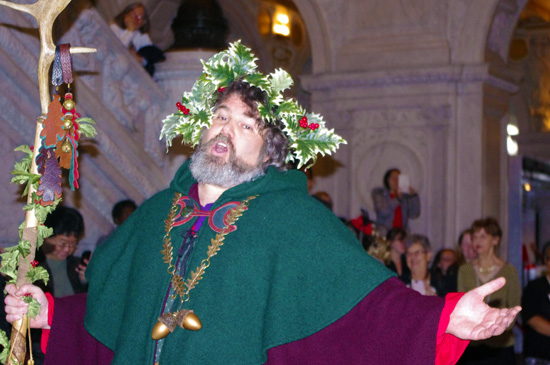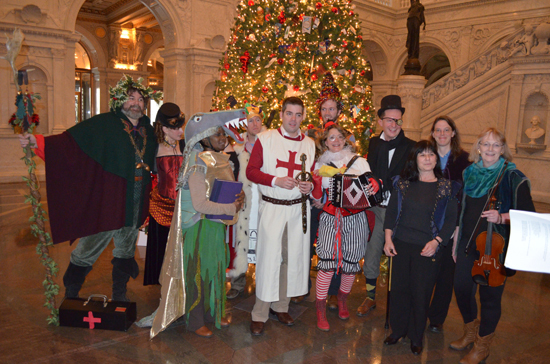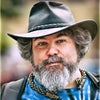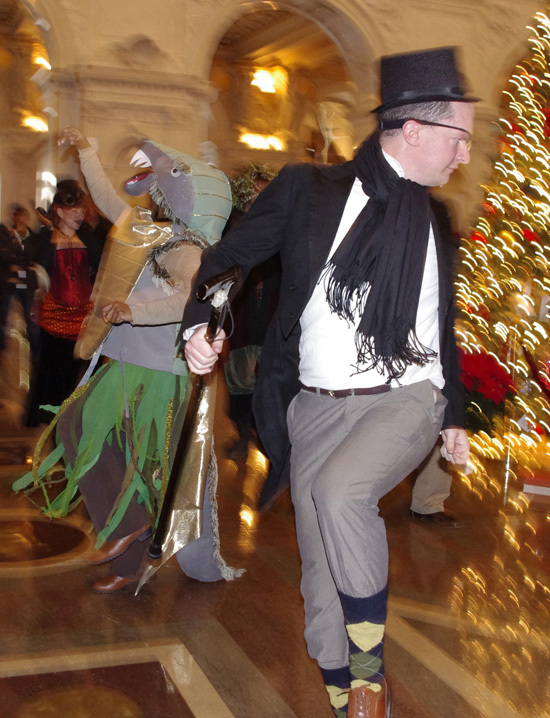
Last year at Christmastime, those masters of satirical pseudo-news at The Onion circulated a video about a group of medieval mummers capturing the imagination of American audiences. My friends were quick to forward this video to me; the two attractive anchorwomen raving about Father Christmas, who is tall and has a "sonorous voice," convinced them this video was about me. My friends and I perform a Mummers Play every year at the Library of Congress, with my tall and sonorous-voiced self as Father Christmas.
 Photo by Stephanie Hall
Photo by Stephanie Hall
Although our group is done mumming for the year, I am mumming once more this season, on January 3 at the Birchmere music hall in Alexandria, Virginia, as part of a big post-Christmas show featuring Celtic rock band Ocean Orchestra and members of the Washington Revels.
What is a Mummers Play, you ask, and what is mumming? Mumming is a word for disguising oneself, going door to door, and performing songs, dances and plays in neighbors' homes and in public places. It's a very old and widespread custom, going back at least to the Middle Ages. As a general practice, mumming can be found throughout Europe and the European diaspora, from Bulgaria to Ireland and from Australia to Newfoundland. It has also given rise to such offshoots as the Philadelphia Mummers Parade, which combines traditional elements with modern music and showmanship.
The type of play we call a Mummers Play today is a little less ancient and less universal. In fact, it may not go back any further than the 18th century, since earlier English-language references to "mumming" either are vague about the exact type of performance, or are clearly a different kind of play. But it still has interesting resonance with ancient themes and obvious connections to older mumming traditions.
These modern Mummers Plays have a basic recurring plot that is used as an excuse for the actors to sing, dance and rhyme. The plot involves a fight between two champions, who can be St. George and the Dragon, or St. Patrick and the Turkish Knight, or any other combination of historical or fantasy characters. Combatants in traditional mumming range from Napoleon to Cromwell, and from "The Duke of Blunderland" to a bloodthirsty soldier called "Cutterman Slasherman." (Nowadays, in fact, you can find Mummers Plays about Captain Kirk, Dracula and other heroes of postmodern pop culture.) In the fight, one of the combatants is killed. A doctor then arrives. After being accused by the others of being a quack, the doctor proceeds to revive the dead hero (and there is much rejoicing).
The Onion's description of "medieval mumming," which refers to what is essentially a modern Mummers Play featuring a "magical apothecary" instead of a quack doctor, is an attempt to project modern plays back into the medieval era. Never mind the inaccuracy, though... The Onion's video actually describes mumming pretty darn well and is funny as hell to boot. (Watch it down below!)
Mumming in the English-speaking world mostly occurs around the Winter Solstice, which makes the death-and-resurrection theme resonate with the world outside the play. It also places the play at a time of year when the nights are long and boring; in the days before electricity this meant that people particularly appreciated entertainment. Finally, it occurs when the plenty of the earth has subsided for the season, and many members of the community are facing lean times. The play is often performed in exchange for food, drink or money, so it allows people to informally redistribute wealth toward those who need it, spreading holiday cheer throughout the community.
 Photo by John Regan
Photo by John Regan
In their death-and-resurrection theme, and their timing near the solstice, Mummers Plays clearly resonate not only with Christian beliefs, but also with earlier pagan beliefs, leading some to theorize that they are vestiges of a pre-Christian pagan ceremony. The problem with this is the almost thousand-year gap between the Christianization of England and the appearance of the plays in the written record. It's unlikely they would have remained undocumented for that long, so my own feeling is that the plays reflect vestiges of pre-Christian thought within Christianity itself. This would make them pagan in flavor but Christian in origin, a solution that's supported by the prevalence of Christian Saints as characters in the plays. Plays of this type are widespread throughout the English-speaking world, including Britain, Ireland, Newfoundland, Kentucky and the Caribbean nation of St. Kitts and Nevis.
The American Folklife Center, the office at the Library of Congress where I work, is lucky to have a collection particularly rich in Mummers Play texts, the James Madison Carpenter Collection. During his fieldwork in Britain in the 1930s, Carpenter collected over 500 texts of folk plays. We adapted our play originally from materials in this collection, then added lines from other folk plays, as well as topical references, which are a traditional aspect of Mummers Play performances. We change the play each year to reflect what's on our minds; our 2012 play at the Library was influenced by the growing popularity of e-books, and the fashion and fantasy literature genre of steampunk, while our Birchmere performance will have a more political bent, with mentions of fiscal cliffs and a cure for an ailment called "Simpson Bowels."
 Photo by John Regan
Photo by John Regan
For interested parties, I have both a lengthier introduction to our 2012 play, and the full text of the play, online at my website, complete with many photos. If you're interested in the Birchmere play, you'll just have to come out and see us. It'll be a small part of a great show, featuring traditional folk songs, medieval carols, high-energy Celtic rock and lots of audience participation. We'd love to see you there!
(Note: the first two photos are by Stephanie Hall, and the others are by John Regan)

